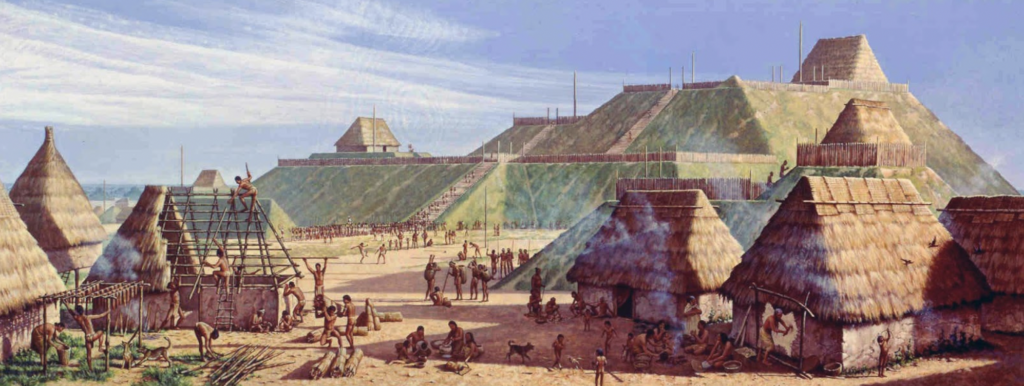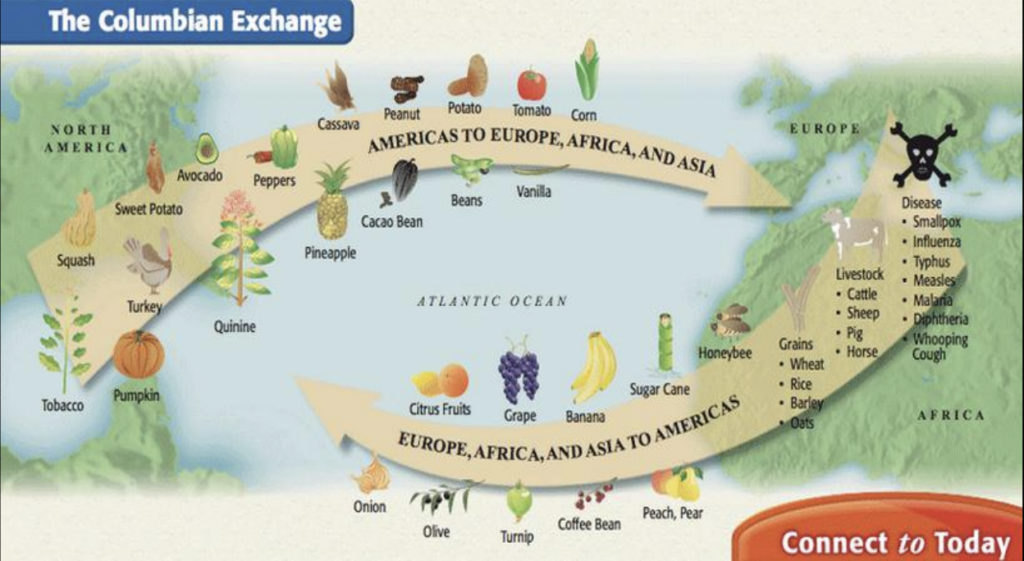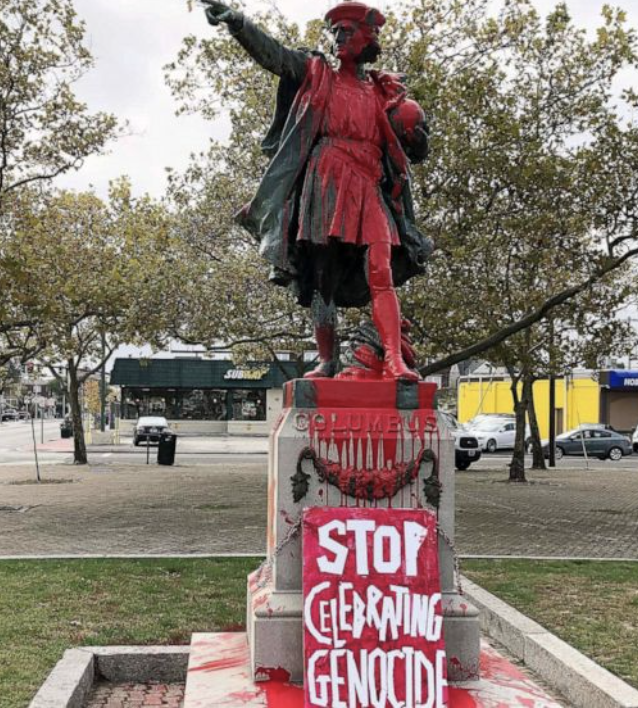Image gateway
Discussion Questions
- What was the Columbian Exchange?
- How did infectious diseases change the history of the Americas?
- What types of evidence appear in Yawp chapter 1?
From popular secondary level textbook:
- For more information on the “so-called Columbian Exchange” (American Yawp), see historian Alfred Crosby’s short essay for the National Humanities Center
From Yawp chapter 1:
But disease was deadlier than any weapon in the European arsenal. It unleashed death on a scale never before seen in human history. Estimates of the population of pre-Columbian America range wildly. Some argue for as much as 100 million, some as low as 2 million. In 1983, Henry Dobyns put the number at 18 million. Whatever the precise estimates, nearly all scholars tell of the utter devastation wrought by European disease. Dobyns estimated that in the first 130 years following European contact, 95 percent of Native Americans perished. (At its worst, Europe’s Black Death peaked at death rates of 35 percent. Nothing else in history rivals the American demographic disaster.) A ten-thousand-year history of disease hit the New World in an instant. Smallpox, typhus, bubonic plague, influenza, mumps, measles: pandemics ravaged populations up and down the continents. Wave after wave of disease crashed relentlessly. Disease flung whole communities into chaos. Others it destroyed completely.
Chapter 1 Primary Sources
- Native American folklore and traditions
- Archaeological remains and artifacts
- Environmental evidence
- DNA and genetic signatures
- Comparative cultural and linguistic norms
- “Communicative technologies” = Paintings, stone carvings, knotted strings (khipu)
- Columbus’s journal (diario) (1492)
- Bartolome Las Casas’s “incendiary account of Spanish abuses” (1540s)
- Other sixteenth-century written European accounts
Close Reading
The American Yawp features an excerpt from Christopher Columbus’ 1492 diario or journal but it doesn’t quite tell the whole story behind this complicated primary source. Here is what the Yawp editors note before sharing excerpts from October 1492:
First encounters between Europeans and Native Americans were dramatic events. In this account we see the assumptions and intentions of Christopher Columbus, as he immediately began assessing the potential of these people to serve European economic interests. He also predicted easy success for missionaries seeking to convert these people to Christianity.
But what that information leaves out is that the fate of the Columbus journal as it “survived” over the centuries. The original (written in Latin) is missing. What remains is a paraphrase and partial copy prepared by Spanish priest (and Indigenous advocate) Bartoleme de Las Casas about forty years after the 1492 voyage. That version also disappeared for a time, “recovered” somewhat mysteriously in the late eighteenth century. Scholars have debated the authenticity of this discovery but most now accept the Las Casas version as the basis for a legitimate reproduction of what Columbus originally wrote. The material presented in the Yawp appendix comes from an 1893 English translation of the recovered Las Casas document.
Thursday, October 11
…Presently many inhabitants of the island assembled. What follows is in the actual words of the Admiral in his book of the first navigation and discovery of the Indies. “I,” he says, ” that we might form great friendship, for I knew that they were a people who could be more easily freed and converted to our holy faith by love than by force, gave to some of them red caps, and glass beads to put round their necks, and many other things of little value, which gave them great pleasure, and made them so much our friends that it was a marvel to see.
They afterwards came to the ship’s boats where we were, swimming and bringing us parrots, cotton threads in skeins, darts, and many other things; and we exchanged them for other things that we gave them, such as glass beads and small bells. In fine, they took all, and gave what they had with good will. It appeared to me to be a race of people very poor in everything. They go as naked as when their mothers bore them, and so do the women, although I did not see more than one young girl.
All I saw were youths, none more than thirty years of age. They are very well made, with very handsome bodies, and very good countenances. Their hair is short and coarse, almost like the hairs of a horse’s tail. They wear the hairs brought down to the eyebrows, except a few locks behind, which they wear long and never cut. They paint themselves black, and they are the color of the Canarians, neither black nor white. Some paint themselves white, others red, and others of what color they find. Some paint their faces, others the whole body, some only round the eyes, others only on the nose.
They neither carry nor know anything of arms, for I showed them swords, and they took them by the blade and cut themselves through ignorance. They have no iron, their darts being wands without iron, some of them having a fish’s tooth at the end, and others being pointed in various ways. They are all of fair stature and size, with good laces, and well made. I saw some with marks of wounds on their bodies, and I made signs to ask what it was, and they gave me to understand that people from other adjacent islands came with the intention of seizing them, and that they defended themselves. I believed, and still believe, that they come here from the mainland to take them prisoners.
They should be good servants and intelligent, for I observed that they quickly took in what was said to them, and I believe that they would easily be made Christians, as it appeared to me that they had no religion, our Lord being pleased, will take hence, at the time of my departure, six natives for your Highnesses that they may learn to speak. I saw no beast of any kind except parrots, on this island.” The above is in the words of the admiral….
Memory & Meaning
- How should we commemorate Columbus?
- NY Times article on Columbus Day controversies in New Jersey (June 2021)
- Columbus statue still standing in Philadelphia (December 2021)



